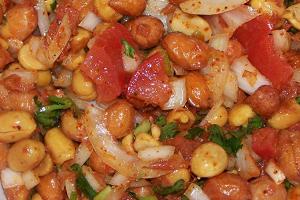I started taking Oats for breakfast recently. I mean, it is not a regular thing but say, a couple of times a week to begin with. My doctor keeps giving his sermons about the Oats benefits as a great fibre food that cleanses the system and as a great cholesterol lowering food. And I do agree with him to some extent.
The topic of interest though is not exactly the benefits of oats or healthy diet but how, of late, the food culture in India is changing to benefit the big multi-national brands. Having oats or cereals for breakfast may be a great healthy option but is it something light on your wallet as well? Why are these MNCs – Multi National Food Companies in India – charging us big time for those products that actually cost one tenth of their MRP (Maximum Retail Price) to produce?
Examples of MNC abuse
The following are some of the great examples of brand abuse by multi-national brands.
McDonald’s French Fries
 Potato is something that is available in abundance in India and McDonald’s didn’t invent it for sure nor is its usage patented by them. We have been cooking potato based curries for 100s of years now and never used it as a main dish. One small portion of French fries cost around 45 rupees ($1) in McDonald’s. The retail price of potato is around 12-15 rupees per kilo and in wholesale sourcing may be at 5-6 rupees. One big potato is all that goes into one small order of fries and hence 1 rupee worth raw material (plus say 1 or 2 rupees worth of oil) is translated to Rs. 45/-. How’s that?
Potato is something that is available in abundance in India and McDonald’s didn’t invent it for sure nor is its usage patented by them. We have been cooking potato based curries for 100s of years now and never used it as a main dish. One small portion of French fries cost around 45 rupees ($1) in McDonald’s. The retail price of potato is around 12-15 rupees per kilo and in wholesale sourcing may be at 5-6 rupees. One big potato is all that goes into one small order of fries and hence 1 rupee worth raw material (plus say 1 or 2 rupees worth of oil) is translated to Rs. 45/-. How’s that?
The same is the story with Pepsi’s Lays chips.
Coke and Pepsi
The cost of producing one litre of Coca cola in India is around 1 rupee I hear. This comes at the expense of tapping the ground water while denying the same for lakhs of people who do not get water for daily usage (Remember the big citizen protest against coke in Kerala – Read wiki story on Coke) and spoiling the environment by not having proper waste water management. The coke is sold at around 40 rupees per liter. Pepsi and Coke managed to kill its Indian competition by acquiring them and discontinuing their products, some of which were actually superior to these MNC brands. The result, you pay more for something that is not at all good for health. And the worst thing is that they are not using the same formulation in India as compared to what they do abroad nor are they sticking to any health, cleanliness and safety standards. Have you seen any coke bottle in India without rusted and dirty caps?
Pizza Hut Pizzas
I have been a big fan of certain pizza brands such as Papa Jones during my stay abroad. Pizza Hut being a big brand, I became an instant fan of the same when they started their operations in India. Initially, I didn’t spend sufficient time to understand their pricing strategy but soon realized that a good quality family size Pizza Hut pizza costs around 450 to 500 rupees. We are talking about the Supreme pizzas as most other things comes without any good toppings. Maida (fine flour) is the main ingredient in a pizza and it is available at a very cheap price in India. Then they top the pizza with a lot of tomatoes and onions (with very little olives, chicken or jalapenos here and there). Ideally this produce should be made available for something like 100-200 rupees for a top class pizza and not 500 for sure. i.e. even with the most expensive items there in, for example 5-10 rupee worth cheese and other stuff. Does anybody question?
Olive oil, Oats, Kellogs flakes etc
The case is much the same with Oats, flakes and what not? The traditional Indian flakes (e.g rice flakes) are something that used to be eaten only by those who lived under the poverty line and in general grains are very cheap in India. 1Kg of Quaker oats cost 120 to 140 rupees in India. Is it fair? Similar is what Kellogs is doing with its umpteen number of flavored flakes.
Olive oil is probably the only exception here because it’s not something that can be easily produced in India and hence need to be imported. I somehow tend to believe that the pricing logic there in cannot be really questioned.
Final thoughts
What I wanted to highlight here are two points. One is the need to avoid those multi-national branded food items that are not healthy. Coke, Pepsi, French fries etc fall into this category. And the second point is that, those healthy but heavily priced items need to be abolished (or their priced brought down) if they have to sell in India. Though we are said to be freed from the British, now we are becoming the slaves of these multi-national brands – even for day to day food requirements.
Can’t we really think of a life without (high-priced) junk food in India? Do you want the next generation to spend all their money on groceries, loans and gas like the way Americans do?
Think about it…
PS:- By the way, yours truly eat and like some of the western food items but only if the pricing and quality are right for me. I also, admit the fact, that there are some brands which are available at extremely good prices (e.g. 1L Tropicana 100% orange juice is available at Rs.85/- which is a great deal). But the McDonalds, Pizza Huts, Coke and Pepsi are the ones against whom we should fight.

 Potato is something that is available in abundance in India and McDonald’s didn’t invent it for sure nor is its usage patented by them. We have been cooking potato based curries for 100s of years now and never used it as a main dish. One small portion of French fries cost around 45 rupees ($1) in McDonald’s. The retail price of potato is around 12-15 rupees per kilo and in wholesale sourcing may be at 5-6 rupees. One big potato is all that goes into one small order of fries and hence 1 rupee worth raw material (plus say 1 or 2 rupees worth of oil) is translated to Rs. 45/-. How’s that?
Potato is something that is available in abundance in India and McDonald’s didn’t invent it for sure nor is its usage patented by them. We have been cooking potato based curries for 100s of years now and never used it as a main dish. One small portion of French fries cost around 45 rupees ($1) in McDonald’s. The retail price of potato is around 12-15 rupees per kilo and in wholesale sourcing may be at 5-6 rupees. One big potato is all that goes into one small order of fries and hence 1 rupee worth raw material (plus say 1 or 2 rupees worth of oil) is translated to Rs. 45/-. How’s that? Peanut Masala is more of a South Indian snack. Well, it is not exactly my favorite food but my vegetarian friends say that it is one of those few veg things that goes well with alcoholic drinks. And as a matter of fact, it does. It can also serve the purpose of an appetizer or starter at times.
Peanut Masala is more of a South Indian snack. Well, it is not exactly my favorite food but my vegetarian friends say that it is one of those few veg things that goes well with alcoholic drinks. And as a matter of fact, it does. It can also serve the purpose of an appetizer or starter at times. In a dessert bowl, add four to five table spoons of those prepared mangoes. Add two scoops of Vanilla ice cream on to it. Add five to six raisins and a teaspoon of the roasted cashews. Poke the whole content three four times with a spoon in a way that the caramel in the mango appears a bit on to the white Ice cream to give it a pleasant texture and look. Be careful not to stir it too much. Garnish with a fresh mint leaf and enjoy before the mangoes turn too cold!
In a dessert bowl, add four to five table spoons of those prepared mangoes. Add two scoops of Vanilla ice cream on to it. Add five to six raisins and a teaspoon of the roasted cashews. Poke the whole content three four times with a spoon in a way that the caramel in the mango appears a bit on to the white Ice cream to give it a pleasant texture and look. Be careful not to stir it too much. Garnish with a fresh mint leaf and enjoy before the mangoes turn too cold!